The Smithsonian Building
A Building Worthy of Smithson's Gift
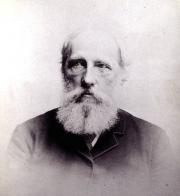
What was the relationship between the Act of Incorporation and the historic Smithsonian Building? The act provided for a building containing an:
- art gallery
- lecture hall
- library
- chemical laboratory
- natural history laboratory
- science museum
A building that housed the multiple functions such as Congress had assigned to the Smithsonian Institution did not exist in the United States in 1846. The Smithsonian Building Committee worked closely with noted architect James Renwick, Jr., to create a Smithsonian building that included an art gallery, a library, a chemical laboratory, lecture halls, and museum galleries.
Renwick designed the Smithsonian Building (now known as the Castle) in a medieval revival style intended to evoke the cloistered, scholarly atmosphere associated with venerable English colleges.


"Nor do I believe that any one . . . in looking upon that building, would mistake its character, or connect it . . . with other than a scientific or collegiate foundation." —Robert Dale Owen, Chairman of the Smithsonian Building Committee, 1849
The building's picturesque quality was heightened by the impression of asymmetry created by nine architecturally distinct towers and the stylistic contrast of the two wings: one a rectangular block with battlements and chimneys, the other chapel-like.
Completed in 1855, the building was at once impressive and controversial.
"The majority of Strangers who visit the city consider it a very beautiful edifice." —Smithsonian Institution Annual Report, 1853
"A monstrous pile of misshapen towers, arches, columns . . ." —Dorothea Dix, social activist and friend of Smithsonian Secretary, Joseph Henry, 1852
Architectural Building Blocks
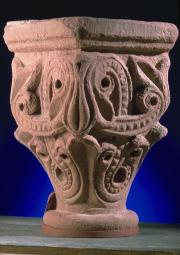 Renwick used several architectural design books as inspiration for the building's carved details but copied none exactly. The building's planners hoped to instill a desire in American architects to become more than mere imitators of style, advising against "implicit copyings" and "servile reproductions."
Renwick used several architectural design books as inspiration for the building's carved details but copied none exactly. The building's planners hoped to instill a desire in American architects to become more than mere imitators of style, advising against "implicit copyings" and "servile reproductions."
Of the hundreds of carved capitals on the Smithsonian Building, only a very few exactly match one another. All shared similar naturalistic design motifs of intertwining leaves, vines, and scrolls.
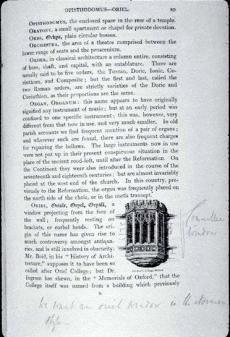 This 1838 English dictionary of architectural terms is the first book purchased for the Smithsonian Institution library. The margin note is in Robert Dale Owen's handwriting:
This 1838 English dictionary of architectural terms is the first book purchased for the Smithsonian Institution library. The margin note is in Robert Dale Owen's handwriting:
"We want an oriel window in the Norman Style." -Robert Dale Owen, Chairman of the Smithsonian Building Committee
The south tower in the center of the Smithsonian Building featured an oriel window. This protruding bay window was inspired by the illustration in this book.
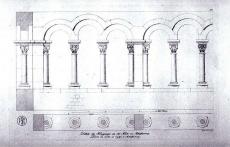 The original Smithsonian Building had open walkways, or "cloisters," patterned after those found in medieval colleges. These cloisters were inspired by this illustration from a book on German medieval architecture. In the belief that the Smithsonian would become a teaching institution, the building's planners included cloisters in their early designs.
The original Smithsonian Building had open walkways, or "cloisters," patterned after those found in medieval colleges. These cloisters were inspired by this illustration from a book on German medieval architecture. In the belief that the Smithsonian would become a teaching institution, the building's planners included cloisters in their early designs.
"The cloisters, or piazzas, connecting the principal building with the extreme wings … will furnish an agreeable promenade for students, professors & visitors, in wet or hot weather." -Letter from David Dale Owen to his brother, Robert Dale Owen, October 10, 1845
The Regents' Room
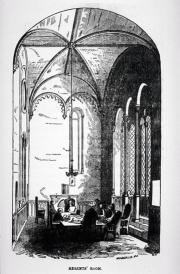
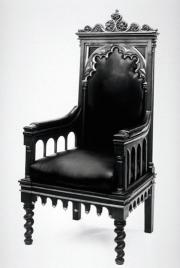 Once the Smithsonian Building opened in 1855, the Smithsonian's Board of Regents, an appointed governing body, conducted business in a room designed by the architect James Renwick, Jr., as a complement to the building's medieval revival design.
Once the Smithsonian Building opened in 1855, the Smithsonian's Board of Regents, an appointed governing body, conducted business in a room designed by the architect James Renwick, Jr., as a complement to the building's medieval revival design.
A narrow but lofty space, the Regents' Room of the new Smithsonian Building featured a 9-meter- (30-foot-) high vaulted Gothic ceiling.
Renwick also designed a massive table and stately armchairs for this room. The chairs featured distinctive Gothic carvings that evoked the building's exterior stonework. Nine of the original eighteen Regents' Room chairs survive.
A Building Model Becomes a Model Building for American Colleges
Renwick built an elaborate and detailed model which was based on plans approved by the Board of Regents. The painted model shows a three story central building. To cut costs, the Regents directed that the number of floors in the building's central section be reduced from the three shown here to two.
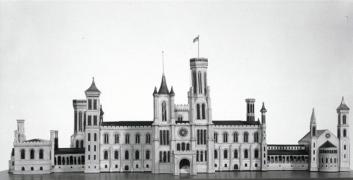
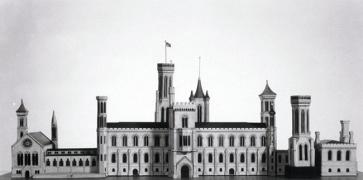
Renwick's model included two options for a second tower at the north entrance. One, with a pointed roof, which contrasted with the taller flat-topped tower, was selected by the Regents. The second option which matched the existing taller tower would have given the building a symmetrical appearance. (The model for the optional flat-tower is shown on the right side of the photograph.)
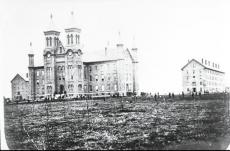 When the Smithsonian Building was built, it became a model for designers of collegiate buildings such as these:
When the Smithsonian Building was built, it became a model for designers of collegiate buildings such as these:
Antioch Hall, Antioch College, Ohio (Original design: 1852)
The two tall central towers with round arch windows and a false gable evoked the Smithsonian Building.
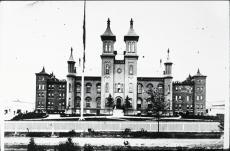
Davis Hall, Worcester Academy, Massachussetts (Original design: 1852)
Elbridge Boyden designed this building, originally a medical college, in a medieval revival style similar to that of the Smithsonian Building.
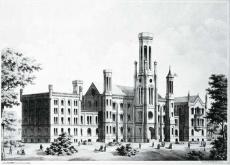
Douglas Hall, University of Chicago (1856-1886) (Original design: 1857-1866)
The asymmetry of the Smithsonian Building was reflected in the design of Douglas Hall, built in 1857-1866 for the first University of Chicago (1856-1886). Many features—the tall front tower with its distinctive finials and round window, the oriel, the round arch windows, the battlements, and the buttresses—link this collegiate building with Renwick's design for the Smithsonian Building.
The Smithsonian and the Public Imagination
The "Smithsonian Polka," composed by W. Bergman, a Washington music teacher, was just one of many expressions of interest once the Smithsonian Building was completed in 1855.
Listen to the Smithsonian Polka, performed by Michael Hendron.


